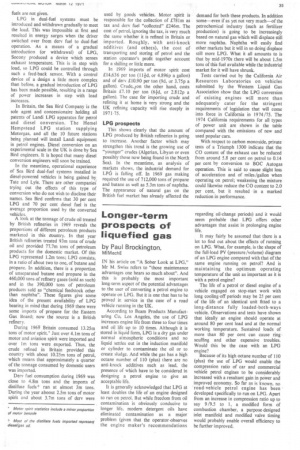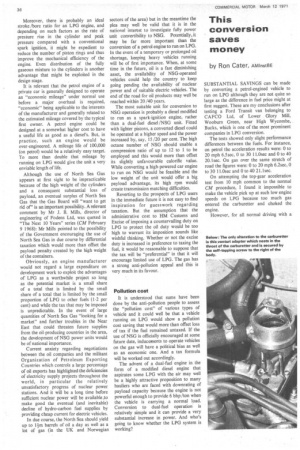Longer-term prospects of liquefied gas
Page 37

Page 38

If you've noticed an error in this article please click here to report it so we can fix it.
by Paul Brockington, MI MechE
IN his article on "A Sober Look at LPG," Mr M. Swiss refers to "those maintenance advantages one hears so much about". And this is probably the most important long-term aspect of the potential advantages to the user of converting a petrol engine to operate on LPG. But it is one that has to be proved in service in the case of a road vehicle running in the UK.
According to Beam Products Manufacturing Co, Los Angeles, the use of LPG increases engine life from three to four times and oil life up to 10 times. Although it is stored in liquid form, LPG is a dry gas under normal atmospheric conditions and no liquid settles out in the induction manifold or cylinder to contaminate the oil or to create sludge. And while the gas has a high octane number of 110 (plus) there are no anti-knock additives such as lead, the presence of which have to be considered in designing a petrol engine to give an acceptable life.
It is generally acknowledged that LPG at least doubles the life of an engine designed to run on petrol. But while freedom from oil contamination is obviously conducive to longer life, modern detergent oils have eliminated contamination as a major problem (given that the operator-observes the engine maker's recommendations regarding oil-change periods) and it would seem probable that LPG offers other advantages that assist in prolonging engine life.
It may fairly be assumed that there is a lot to find out about the effects of running on LPG. What, for example, is the shape of the full-load PV (pressure/volume) diagram of an LPG engine compared with that of the same engine running on petrol? And is maintaining the optimum operating temperature of the unit as important as it is with a petrol engine?
The life of a petrol or diesel engine of a vehicle engaged on stop-start work with long cooling-off periods may be 25 per cent of the life of an identical unit fitted to a long-distance fully loaded-both-ways vehicle. Observations and tests have shown that ideally an engine should operate at around 80 per cent load and at the normal working temperature. Sustained loads of more than 80 per .Cent can cause ring • scuffing and other expensive troubles. Would this be the case with an LPG engine?
Because of its high octane number of 110 (plus) the use of LPG would enable the compression ratio of car and commercial vehicle petrol engines to be considerably increased with a resultant gain in power and improved economy. So far as is known. no 'road-vehicle petrol engine has been developed specifically to run on LPG. Apart from an increase in compression ratio up to say 9/9.5 to 1, a modified form of combustion chamber, a purpose-designed inlet manifold and modified valve tinning would probably enable overall efficiency to be further improved. Moreover, there is probably an ideal stroke /bore ratio for an LPG engine, and depending on such factors as the rate of presiure rise in the cylinder and peak pressure compared with a conventional spark ignition, it might be expedient to reduce the number of piston rings and thus improve the mechanical efficiency of the engine. Even distribution of the fully gaseous mixture to the cylinders is another advantage that might be exploited in the design stage.
It is relevant that the petrol engine of a private car is generally designed to operate an "economic mileage" under normal use before a major overhaul is required, "economic" being applicable to the interests of the manufacturer and generally related to the estimated mileage covered by the typical first owner. A petrol engine could be designed at a somewhat higher cost to have a useful life as good as a diesel's. But, in practice, such an engine would be over-engineered. A mileage life of 100,000 (on petrol) would be a relatively easy target. To more than double that mileage by running on LPG would give the unit a very enviable length of life.
Although the use of North Sea Gas appears at first sight to be impracticable because of the high weight of the cylinders and a consequent substantial loss of payload, an eventual surplus of North Sea Gas that the Gas Board will "want to get rid or' is an important possibility. A relevant comment by Mr J. B. Mills, director of engineering of Fodens Ltd, was quoted in "The Next 10 Years" series (CM February 9 1968): Mr Mills pointed to the possibility of the Government encouraging the use of North Sea Gas in due course by differential taxation which would more than offset the payload penalty created by the high weight of the containers.
Obviously, an engine manufacturer would not regard a large expenditure on development work to exploit the advantages of LPG as a worthwhile project so long as the potential market is a small share of a total that is limited by the small share of a total that is limited by the small proportion of LPG to other fuels (1-2 per cent) and while the tax that may be imposed is unpredictable. In the event of large quantities of North Sea Gas "looking for a market" and further troubles in the Near East that could threaten future supplies from the oil-producing countries in the area, the development of NSG power units would be of national importance.
Current anxiety regarding negotiations between the oil companies and the militant Organization of Petroleum Exporting Countries which controls a large percentage of oil exports has highlighted the deficiencies of electricity supply projects throughout the world, in particular the relatively unsatisfactory progress of nuclear power stations. And it will be a long time before sufficient nuclear power will be available ,to make good the eventual (and inevitable) decline of hydro-carbon fuel supplies by providing cheap current for electric vehicles.
In due course, the North Sea should yield up to barrels of oil a day as well as a lot of gas (in the UK and Norwegian
sectors of the area) but in the meantime the plea may well be valid that it is in the national interest to investigate fully power unit convertibility to NSG. Potentially, it may be far more important than the conversion of a petrol engine to run on LPG. In the event of a temporary or prolonged oil shortage, keeping heavy vehicles running will be of first importance. When, at some time in the future, oil is a fast diminishing asset, the availability of NSG-operated vehicles could help the country to keep going pending the availability of nuclear power and of suitable electric vehicles. The end of the road for oil products may well be reached within 20/40 years.
The most suitable unit for conversion to NSG operation is probably a diesel modified to run as a spark-ignition engine, rather than a dual-fuel diesel /NSG unit. Fitted with lighter pistons, a converted diesel could be operated at a higher speed and the power increased by, say, 15 /20 per cent. The high octane number of NSG should enable a compression ratio of up to 12 to 1 to be employed and this would more than offset its slightly unfavourable calorific value. While converting a high-powered car engine to run on NSG would be feasible and the low weight of the unit would offer a big payload advantage, its high rpm would create transmission matching difficulties.
Reverting to the prospects of LPG users in the immediate future it is not easy to find inspiration for guesswork regarding taxation. But the assumption that the administrative cost to HM Customs and Excise of imposing a countervailing duty on LPG to protect the oil duty would be to high to warrant its imposition sounds like wishful thinking. Whether or not the excise duty is increased in preference to taxing the fuel, it would be reasonable to suppose that the tax will be "preferential" in that it will encourage limited use of LPG. The gas has a strong anti-pollution appeal and this is very much in its favour.
Pollution cost It is understood that sums have been done by the anti-pollution people to assess the "pollution cost" of various types of vehicle and it could well be that a vehicle running on LPG would show a pollution cost saving that would more than offset loss of tax if the fuel remained untaxed. If the use of NSG is officially encouraged at some future date, inducements to operate vehicles on the gas will have a political bias as well as an economic one. And a tax formula will be worked out accordingly.
The advent of a dual-fuel engine in the form of a modified diesel engine that aspirates some LPG with the air may well be a highly attractive proposition to many hauliers who are faced with downrating of payload capacity because the engine is not powerful enough to provide 6 bhp/ton when the vehicle is carrying a normal load. Conversion to dual-fuel operation is relatively simple and it can provide a very substantial increase in power. And who's going to know whether the LPG system is working?






















































































